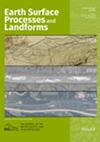Lukas WinklerPrins, Jessica R. Lacy, Mark T. Stacey, Karen Thorne, McKenna Bristow, Scott Jones
下载PDF
{"title":"Comparison of creek and bay influences on salt marsh sediment budget and deposition patterns","authors":"Lukas WinklerPrins, Jessica R. Lacy, Mark T. Stacey, Karen Thorne, McKenna Bristow, Scott Jones","doi":"10.1002/esp.70137","DOIUrl":null,"url":null,"abstract":"<p>The resilience of salt marshes with low organic production depends on their effective capture and retention of mineral sediment from adjacent waters. Little prior work has directly compared mechanisms of sediment import from wave-influenced marsh boundaries against those of tidal creeks. We used simultaneous deployment of net-deposition tiles and oceanographic sensors to identify the timing and magnitude of sediment import/export to, and redistribution within, a marsh in south San Francisco Bay. As the marsh has both an eroding bay-exposed scarp and a prominent tidal creek, we investigated the mechanisms and magnitudes of sediment import from the marsh-bay versus the marsh-creek interface. The strong daily sea breezes of the summer season produced most of the wave-driven erosion of the marsh scarp and controlled suspended sediment concentrations; the winter season had weaker winds punctuated by a few storms. A large seasonal difference in suspended sediment concentrations influenced both flood and ebb sediment fluxes to the marsh and led to much higher rates of import in the summer. Both bay-side and creek-side processes were important to total marsh sediment budget. Bay-side sediment contributions were more variable in time due to the bay-influenced environment, and creek-side contributions were overall larger, reflecting the large proportion of the marsh fed by creek water. Sediment was redistributed throughout the system, with erosion near the bay-edge, accretion near the creek-edge and slow import to the marsh interior. The marsh was net importing sediment in the summer and exporting in the winter from different rates of these processes; on an annual scale, the marsh was net importing despite rapid lateral marsh loss. These findings emphasize that a positive sediment budget does not imply a stable marsh and that both creek- and edge-side dynamics are important for marsh sedimentation and geomorphic trajectories. Further, we expand understandings of non-storm and seasonal controls on marsh sedimentation. Copyright © 2025 John Wiley & Sons, Ltd.</p>","PeriodicalId":11408,"journal":{"name":"Earth Surface Processes and Landforms","volume":"50 11","pages":""},"PeriodicalIF":2.7000,"publicationDate":"2025-09-01","publicationTypes":"Journal Article","fieldsOfStudy":null,"isOpenAccess":false,"openAccessPdf":"https://onlinelibrary.wiley.com/doi/epdf/10.1002/esp.70137","citationCount":"0","resultStr":null,"platform":"Semanticscholar","paperid":null,"PeriodicalName":"Earth Surface Processes and Landforms","FirstCategoryId":"89","ListUrlMain":"https://onlinelibrary.wiley.com/doi/10.1002/esp.70137","RegionNum":3,"RegionCategory":"地球科学","ArticlePicture":[],"TitleCN":null,"AbstractTextCN":null,"PMCID":null,"EPubDate":"","PubModel":"","JCR":"Q2","JCRName":"GEOGRAPHY, PHYSICAL","Score":null,"Total":0}
引用次数: 0
引用
批量引用
Abstract
The resilience of salt marshes with low organic production depends on their effective capture and retention of mineral sediment from adjacent waters. Little prior work has directly compared mechanisms of sediment import from wave-influenced marsh boundaries against those of tidal creeks. We used simultaneous deployment of net-deposition tiles and oceanographic sensors to identify the timing and magnitude of sediment import/export to, and redistribution within, a marsh in south San Francisco Bay. As the marsh has both an eroding bay-exposed scarp and a prominent tidal creek, we investigated the mechanisms and magnitudes of sediment import from the marsh-bay versus the marsh-creek interface. The strong daily sea breezes of the summer season produced most of the wave-driven erosion of the marsh scarp and controlled suspended sediment concentrations; the winter season had weaker winds punctuated by a few storms. A large seasonal difference in suspended sediment concentrations influenced both flood and ebb sediment fluxes to the marsh and led to much higher rates of import in the summer. Both bay-side and creek-side processes were important to total marsh sediment budget. Bay-side sediment contributions were more variable in time due to the bay-influenced environment, and creek-side contributions were overall larger, reflecting the large proportion of the marsh fed by creek water. Sediment was redistributed throughout the system, with erosion near the bay-edge, accretion near the creek-edge and slow import to the marsh interior. The marsh was net importing sediment in the summer and exporting in the winter from different rates of these processes; on an annual scale, the marsh was net importing despite rapid lateral marsh loss. These findings emphasize that a positive sediment budget does not imply a stable marsh and that both creek- and edge-side dynamics are important for marsh sedimentation and geomorphic trajectories. Further, we expand understandings of non-storm and seasonal controls on marsh sedimentation. Copyright © 2025 John Wiley & Sons, Ltd.
浅滩与海湾对盐沼泥沙收支及沉积模式影响的比较
有机产量低的盐沼的恢复力取决于它们对邻近水域矿物沉积物的有效捕获和保留。以前很少有工作直接比较波浪影响的沼泽边界和潮汐溪的沉积物输入机制。我们同时部署了净沉积瓦和海洋传感器,以确定沉积物输入/输出的时间和大小,以及在旧金山湾南部沼泽中的再分配。由于沼泽既有暴露于海湾的侵蚀陡坡,也有突出的潮汐溪,我们研究了从沼泽湾和沼泽溪界面输入沉积物的机制和大小。夏季每天强烈的海风产生了大部分由波浪驱动的沼泽悬崖侵蚀,并控制了悬浮沉积物的浓度;冬天的风比较弱,偶尔会有几场暴风雨。悬沙浓度的季节性差异很大,影响了洪水和退潮时进入沼泽的泥沙通量,并导致夏季进口速率高得多。湾侧和溪侧过程对湿地泥沙收支总量均有重要影响。由于受海湾环境的影响,湾侧沉积物的贡献在时间上的变化更大,而溪侧的贡献总体上更大,反映了由溪水供养的沼泽的比例很大。沉积物在整个系统中被重新分配,在海湾边缘附近被侵蚀,在小溪边缘附近被淤积,并缓慢地向沼泽内部输入。沼泽在夏季净输入泥沙,在冬季净输出泥沙;在年尺度上,尽管沼泽的横向损失迅速,但沼泽是净输入的。这些发现强调,一个正的泥沙收支并不意味着一个稳定的沼泽,溪流和边缘的动力学对沼泽的沉积和地貌轨迹都很重要。此外,我们扩大了对沼泽沉积的非风暴和季节性控制的理解。版权所有©2025 John Wiley &; Sons, Ltd
本文章由计算机程序翻译,如有差异,请以英文原文为准。


 求助内容:
求助内容: 应助结果提醒方式:
应助结果提醒方式:


